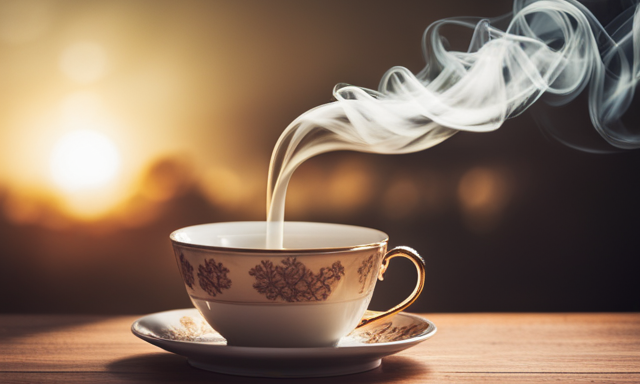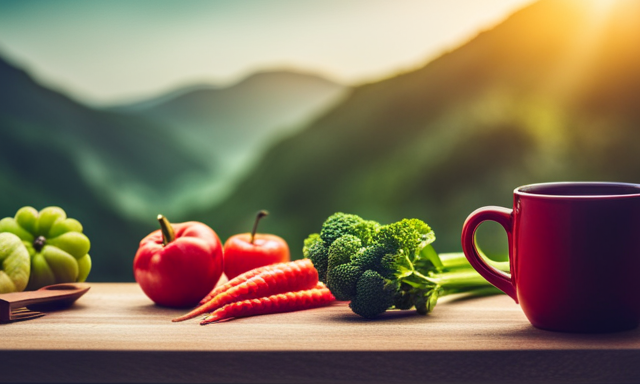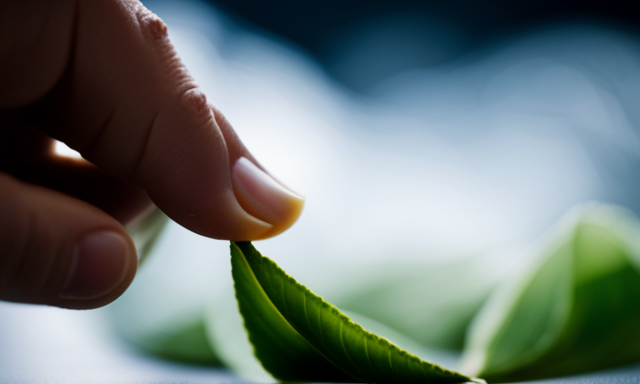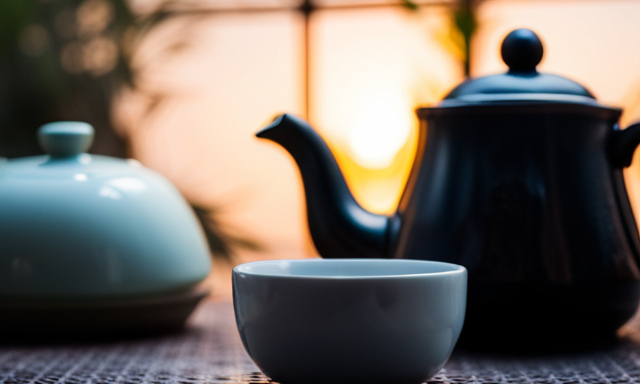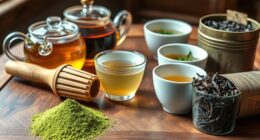Hey there, tea enthusiasts! Ready to embark on a journey of aroma and flavor? Well, look no further, because I’m here to guide you through the art of brewing a pot of delightful loose leaf jasmine and oolong tea. Trust me, it’s like a little slice of heaven in a teapot!
Now, you might be wondering why I’m so passionate about this particular blend. Well, let me tell you, jasmine and oolong tea is a match made in tea paradise. The delicate floral notes of jasmine beautifully complement the rich and earthy flavors of oolong, creating a truly unforgettable experience for your taste buds.
In this article, I’ll walk you through the process step by step, from selecting the highest quality loose-leaf tea to enhancing the flavor with a few additional ingredients. So, grab your favorite teapot and get ready to brew a pot of tea that will transport you to a world of pure bliss.
Let’s get started, shall we?
Key Takeaways
- Use a tea strainer to filter out leaves
- Enhance the tea experience with a traditional tea set
- Enjoy the tea with small, deliberate sips to fully appreciate flavors and aromas
- Jasmine and oolong tea have health benefits, including improving digestion and boosting the immune system
Understanding the Different Types of Jasmine and Oolong Tea
Now that you’re ready to dive into the world of loose leaf jasmine and oolong tea, let’s explore the fascinating array of different types that will tantalize your taste buds like never before!
Jasmine tea is a fragrant and delicate tea that’s infused with the aroma of jasmine flowers. It comes in various varieties such as green tea jasmine, white tea jasmine, and black tea jasmine. Each type offers a unique flavor profile and aroma, making it a delightful choice for tea enthusiasts.
On the other hand, oolong tea is a partially oxidized tea that falls between green and black tea. It’s known for its rich and complex flavors, ranging from floral and fruity to toasty and nutty.
Both jasmine and oolong teas offer numerous health benefits, including improved digestion, reduced stress, and enhanced immune function.
Now, let’s move on to selecting high-quality loose-leaf tea.
Selecting High-Quality Loose-Leaf Tea
When it comes to selecting high-quality loose-leaf tea, I always look for the best jasmine tea. I consider the appearance and aroma of the leaves. The tea leaves should have a vibrant green color and a delicate, floral scent.
As for oolong tea, I search for leaves that are tightly rolled and have a rich, earthy fragrance.
Tips for Choosing the Best Jasmine Tea
To find the best jasmine tea for you, simply trust your taste buds and let the fragrant leaves whisk you away to a tranquil oasis of flavor and relaxation. When choosing the best tea brand, consider the following:
- Scent: Look for a tea with a strong, floral aroma that’ll transport you to a blooming jasmine garden.
- Appearance: The leaves should be tightly rolled and have a vibrant green color, indicating freshness.
- Origin: Opt for teas from reputable regions like Fujian, China, where jasmine tea’s been produced for centuries.
- Quality: Select teas made with high-quality green tea leaves, hand-picked and delicately scented with jasmine flowers.
Drinking jasmine tea not only delights your senses but also offers numerous health benefits. It aids in digestion, boosts the immune system, and promotes relaxation.
Now, let’s explore the world of oolong tea and find the perfect leaves to create a delightful brew.
Finding the Perfect Oolong Tea Leaves
Delighting in the fragrant leaves of oolong tea allows me to embark on a journey of rich flavors and subtle complexities. When it comes to finding rare oolong teas, it’s like uncovering hidden treasures.
Exploring oolong tea regions opens up a world of possibilities, from the high mountains of Taiwan to the lush gardens of Fujian, China. Each region imparts its unique characteristics to the oolong leaves, resulting in a diverse range of flavors and aromas.
Whether it’s the floral notes of Tie Guan Yin or the fruity undertones of Da Hong Pao, there is an oolong tea to suit every palate.
Now, let’s move on to preparing your teapot and tea leaves for the perfect brew, ensuring that every sip is a moment of pure bliss.
Preparing Your Teapot and Tea Leaves
Before you begin, take a moment to carefully inspect your teapot, feeling its smooth ceramic surface and admiring the intricate design that will soon hold the fragrant infusion of jasmine and oolong tea.
Properly preparing your teapot is essential for a flavorful brew. Start by ensuring your teapot is clean and free from any residue. Give it a gentle wash with warm water and mild soap, rinsing thoroughly afterwards.
Next, measure the perfect amount of tea leaves for your pot. Use approximately one teaspoon of loose leaf tea per cup of water, adjusting to your preferred strength.
Once your teapot is clean and your tea leaves are measured, you’re ready to move on to the next step: infusing the tea.
Infusing the Tea
When it comes to brewing jasmine tea, it’s crucial to pay attention to the water temperature and steeping time. The delicate floral flavors of jasmine tea are best extracted with water that’s around 175°F (80°C).
Steeping the tea for 2-3 minutes allows the flavors to fully develop without becoming too bitter.
On the other hand, oolong tea requires a unique brewing technique. The water temperature should be slightly higher, around 195°F (90°C), and the tea leaves should be steeped for 3-5 minutes to bring out the complex flavors and aromas of the oolong leaves.
Proper Water Temperature and Steeping Time for Jasmine Tea
Achieving the perfect water temperature and steeping time will ensure a fragrant and soothing cup of jasmine tea that will transport you to a tranquil oasis. For brewing jasmine tea, it’s essential to use water at a temperature around 175°F (80°C). This temperature allows the delicate jasmine blossoms to release their aromatic oils without scorching the leaves. Steeping the tea for about 2-3 minutes will bring out the full flavor and fragrance of the jasmine.
Oolong tea, on the other hand, requires a slightly higher water temperature of 195°F (90°C) to fully unlock its complex flavors. Steep the oolong tea for 3-5 minutes to achieve the desired strength.
Now, let’s delve into the unique brewing technique for oolong tea, which will further elevate your tea experience.
Unveiling the Unique Brewing Technique for Oolong Tea
Let’s uncover the secret method to create an exquisite infusion of oolong that’ll leave your taste buds in awe. When it comes to oolong tea, unique brewing techniques play a crucial role in unlocking its rich and complex flavors. Here are four key steps to follow:
-
Selecting the right oolong tea leaves: Opt for high-quality loose leaf oolong tea that suits your taste preferences, whether it’s a floral, fruity, or roasted flavor profile.
-
Preparing the water temperature: Heat the water to around 195°F (90°C) to bring out the best flavors of oolong tea without overpowering it.
-
Steeping time: Allow the leaves to steep for 2-3 minutes to extract the delicate flavors and aromas. Adjust the steeping time based on your desired strength.
-
Multiple infusions: Oolong tea leaves can be steeped multiple times, so experiment with different steeping durations to explore the evolving flavors.
Now that you’ve mastered the unique brewing techniques for oolong tea, let’s dive into enhancing its flavor with additional ingredients in the next section.
Enhancing the Flavor with Additional Ingredients
To amplify the flavor of your loose leaf jasmine and oolong tea, you can add a splash of honey to create a subtly sweet taste that perfectly complements the floral notes. Not only does this addition enhance the aroma of the tea, but it also brings numerous health benefits. Honey is known for its antioxidant and anti-inflammatory properties, which can boost your immune system and promote overall well-being. Additionally, the natural sweetness of honey reduces the need for added sugars, making it a healthier option for those looking to cut down on their sugar intake.
To better understand the benefits of adding honey to your tea, take a look at the table below:
| Benefits of Adding Honey |
|---|
| Enhanced aroma |
| Antioxidant properties |
| Anti-inflammatory effects |
| Boosted immune system |
| Reduced sugar intake |
By incorporating honey into your brewing process, you not only enhance the flavor of your tea but also reap the various health benefits it offers. Now, let’s move on to the next section to learn about serving and enjoying your tea.
Serving and Enjoying Your Tea
Get ready to savor the delightful experience of serving and enjoying your perfectly brewed cup of tea. When it comes to serving loose leaf jasmine and oolong tea, there are a few key points to keep in mind.
Firstly, it’s important to adhere to tea serving etiquette. This includes using a tea strainer to filter out any leaves before pouring the tea into cups. Additionally, serving the tea in a traditional tea set can enhance the experience and make it feel more authentic.
As for enjoying your tea, take small, deliberate sips to fully appreciate the flavors and aromas.
In terms of health benefits, both jasmine and oolong tea are known to have numerous positive effects on the body. From improving digestion to boosting the immune system, these teas can provide a soothing and beneficial experience for both the mind and body.
Frequently Asked Questions
How long does loose-leaf jasmine and oolong tea stay fresh for?
Loose-leaf jasmine and oolong tea stay fresh for up to 6 months when stored properly. Factors like air, light, moisture, and temperature affect their freshness. To maintain longevity, store them in airtight containers away from sunlight and strong odors.
Can you reuse the tea leaves for a second infusion?
Yes, you can reuse the tea leaves for a second infusion. It’s a great way to save money and reduce waste. Just steep them again for a shorter time to enjoy another flavorful cup of tea.
How should I store my loose-leaf jasmine and oolong tea to maintain its quality?
To maintain the quality of loose-leaf jasmine and oolong tea, store it in an airtight container in a cool, dark place away from strong odors. Remember, "a stitch in time saves nine." Follow best brewing methods for a delightful cup.
Can I add milk or sugar to my jasmine and oolong tea?
Yes, you can add milk to jasmine tea for a creamy taste, but it may overpower the delicate floral notes. Oolong tea is often enjoyed without sugar, but adding a touch can enhance its natural sweetness.
Are there any health benefits associated with drinking jasmine and oolong tea?
Drinking jasmine and oolong tea is like a refreshing elixir for your body. It offers numerous health benefits, including improved digestion, enhanced metabolism, and reduced risk of heart disease. Make it a part of your daily routine for a healthier you.
Conclusion
In conclusion, brewing a pot of loose-leaf jasmine and oolong tea is a delightful and aromatic experience. By understanding the different types of tea, selecting high-quality leaves, and properly infusing the tea, you can create a cup of perfection.
Just imagine the fragrant steam rising from your teapot, swirling around like a gentle mist, enveloping you in a soothing embrace. With each sip, you’ll be transported to a serene garden, where the flavors dance on your palate like delicate petals.
So go ahead, indulge in the art of tea brewing and savor the moment.

